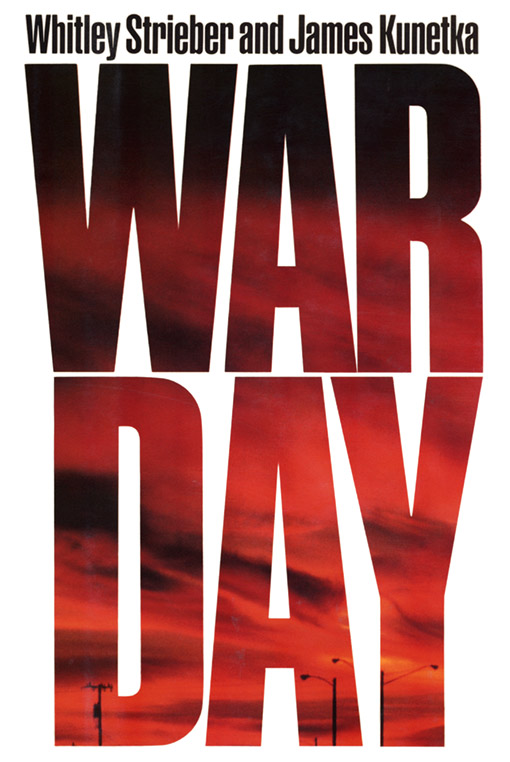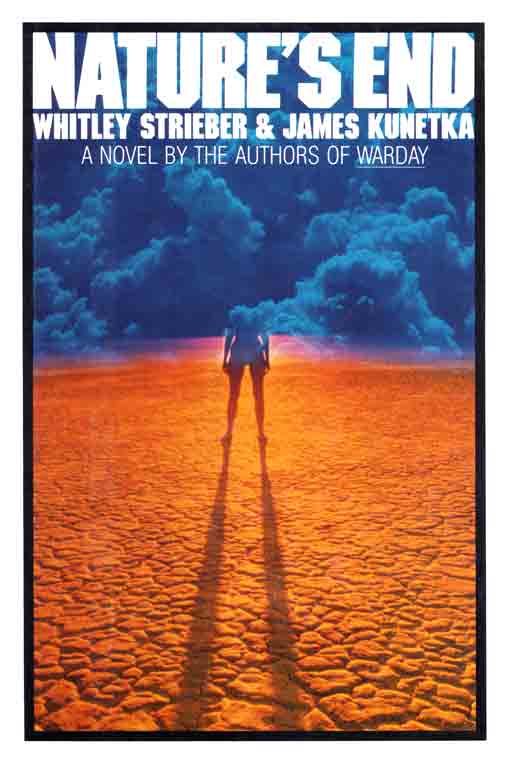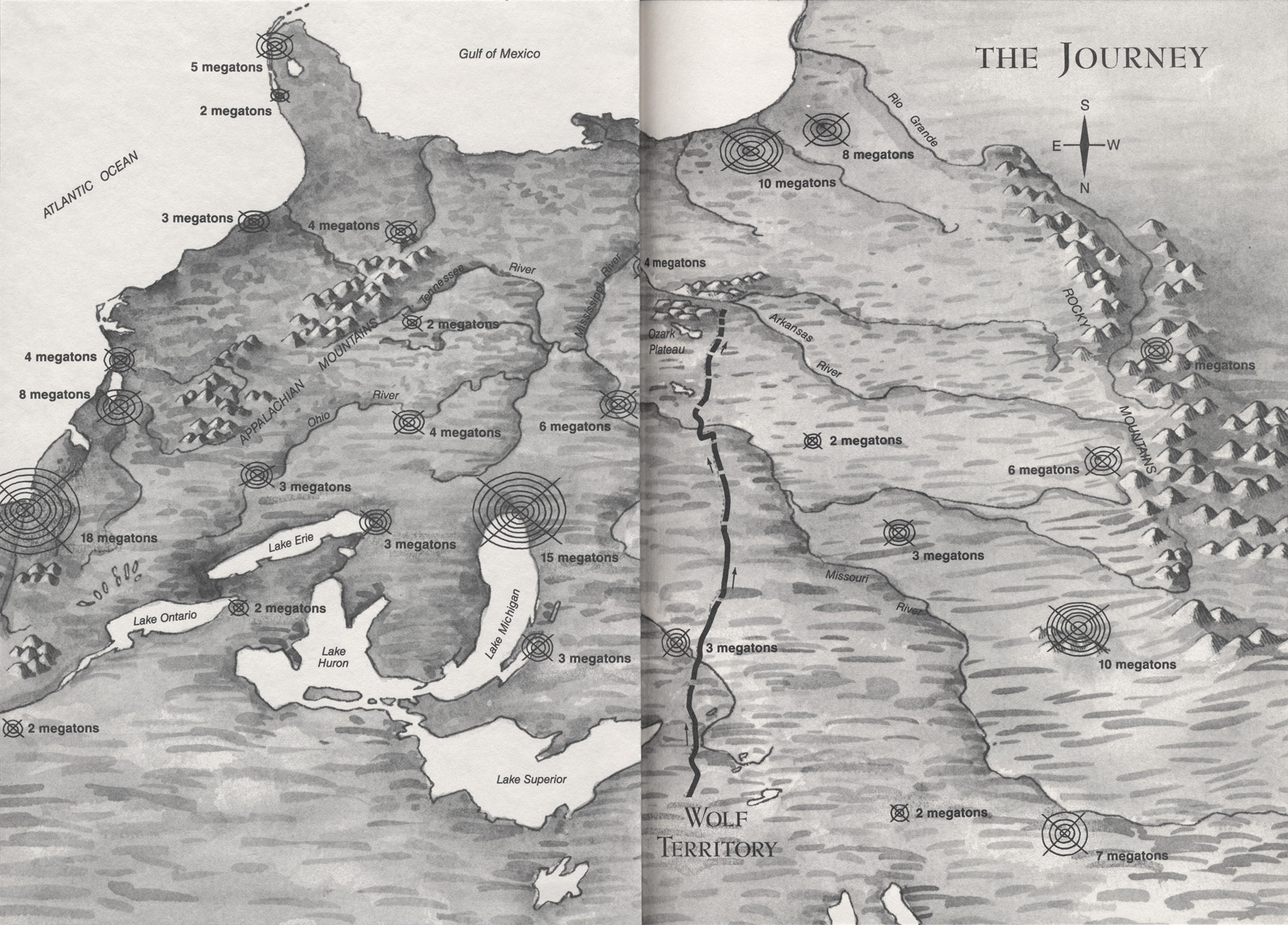



 |
 |
 |
WarDayby Whitley Strieber |
Wolf of Shadowsby Whitley Strieber |
Nature's Endby Whitley Strieber |
Warday and the Journey Onward
Published April 1984
October 28, 1988. Warday.
It lasted only thirty-six minutes and when it
was over, much of the earth remained untouched. But in those thirty-six minutes,
a world had been destroyed.
Seven million Americans died in the immediate
blast. Millions more would die of radiation, famine, and disease during the
next five years. Millions also lived, strung out across a country that knew
it had been hit – but not why. Or where. Or how.
In the days and months that followed, an America
blacked out by the breakdown of its communications systems and wrestling with
the demands of an unprecedented emergency struggled first for survival. Later
it would seek answers – seek to find out how it happened, who had survived,
what was left.
Five years after Warday, the answers have yet
to be found. America is still a strange place, filled with haunting relics of
the past, constant reminders of what was lost. But survival is no longer in
question. It is time to take stock.
And so, five years after the missiles detonated,
two survivors set forth on a trek across America. Determined to find out what
has happened to the rest of the country, their will be a journey of discovery
filled with pain and hope. From Texas to California, across the vast distances
of the Great Plains, into the once-bold centers of commerce and power along
the eastern coast, and through the small cities and rural hamlets of the South
– amid pockets of resurgence and remnants of destruction, they will hear
America speaking: remembering the past, willing the present, longing for a future.
Warday: It takes you into a world you couldn’t
imagine.
A work of fiction that reads like fact, Warday is the result of a skillful blending of the talents of Whitley Strieber (author of The Wolfen and The Hunger) and James W. Kunetka (author of City of Fire: Los Alamos and the Atomic Age, 1943–1945 and Oppenheimer: The Years of Risk). Texans by birth, best friends since childhood, and well-versed in the scientific and technological data underpinning the novel, they unite in one voice to depict an America in the aftermath of nuclear war. Though Warday is set in 1993, nothing in it is beyond the possible, technologically or politically. This is what gives the novel its terrifying truth.
“A
first-rate novel, as real as snapshots of tomorrow. And as scary.” –
New York Daily News
“Haunting...horrifying...engrossing...an
all too believable look at what could be
the future.” – United Press International
“Disturbingly
plausible...its vision of post-nuclear chaos exceeds 'The Day
After'.” – Newsweek
“Imaginative...entertaining
reading.” – Boston Herald
“Frightening...controversial...a
futuristic thriller.” – Chicago Tribune
“Extraordinary...a
book that conceivably could make a difference. You owe it to yourself
to read it.” – Cosmopolitan
Warday
© 1984 Wilson & Neff, Inc. and James Kunetka
Synopsis courtesy of Holt, Rinehart and Winston
Jacket design by Robert Reed, Jacket typography by Andrew M. Newman, Front Jacket
photograph by Gary Gladstone, The Image Bank.
![]()
Wolf of Shadows
Published 1985
Awards:
· Outstanding Children's Book of the Year by the American
Library Association,
· 1986 Olive Branch Award as the outstanding book
of the year for young people on the subject of world peace,
· Outstanding Science Book for Children by the National
Science Teacher's Assoc.
One quiet spring evening, the animals of the north woods see a great light mushroom
up from the human territories. Most ignore it, but Wolf of Shadows, sitting alone
on his hill, knows that something is terribly wrong. The next day ashen clouds
block out the sun, and an icy black rain comes, washing away the smells of all
living things. It gets colder, then colder still. Nuclear winter has begun.
As sleet changes to snow in wolf country, a desperate
human mother and her daughter appear and join Wolf of Shadows as he leads his
pack south. This is the story of their journey – a dark odyssey through the
desolate, frozen wasteland that was once the United States. Always near freezing
and starvation, threatened by savage dog packs and marauding humans, the wolves
and the two women soon come to depend on one another for survival. As their journey
progresses, an unspoken buy deeply felt love grows between them. This alone sustains
them in their search for a place where life can be reborn.
Wolf of Shadows is more than a compelling
tale of survival in the wild. It is a unique, passionately wrought vision –
told, hauntingly, from the viewpoint of Wolf of Shadows himself – of the
horror we may bring to every living creature on earth.

Wolf of Shadows is...
“…not just another book on the horrors of nuclear war. Though written for younger readers, I suspect that their elders are more in need of this jolt to the imagination.” – Paul Warnke, Former Director, U.S. Arms Control and Disarmament Agency; Chief Negotiator for SALT II
“…able to portray for children the horrors of nuclear war without damaging the spirit. It is the story's warmth which allows it to teach and reveal without instilling a depressing or terrifying fear.” – Congressman Edward J. Markey, Author of the nuclear freeze resolution in the U.S. House of Representatives
“…an extraordinary book of beauty and tears. Anyone who loves this opal planet that is our home should read it.” – Jean Craighead George, Author of Newbery Medal winner Julie of the Wolves
“...powerful. Like the wolves of his story who challenge a rival by staring it down, Whitley Strieber has chosen to address nuclear fears by facing them boldly.” – The New York Times Book Review
“…brilliantly told and terrifying.” – Roger Caras, Author and wildlife expert
Wolf of Shadows
© 1985 Wilson & Neff, Inc.
Synopsis courtesy of Alfred A. Knopf, Inc.
Hardcover jacket illustration by Marc Rosenthal.
Front and end piece map illustration by David Lindroth (hardcover edition only).
![]()
Nature's End: The Consequences of the Twentieth Century
Published 21 April 1986
Imagine cities with blackened air, where men, women, and children gasp for breath.
Imagine a countryside with almost no trees...a land where severe droughts, dust
storms, and forest fires rage. Imagine an America of astonishing achievements
– but so overpopulated and ravaged by its own excesses that it totters on
the brink of the destiny predicted long ago in Rachel Carson’s Silent
Spring.
This is the world that confronts us in Nature’s
End – a world only a few years from now. With all the vivid detail, compassion,
and compelling suspense of their New York Times bestseller, the highly acclaimed Warday, Whitley Strieber and James Kunetka now bring us another riveting
novel based on scientific fact. Where their earlier book depicted the grim reality
of nuclear war, Nature’s End portrays, with the same powerful documentary
style, a devastation even more likely to occur: total environmental collapse.
It is a crisis that will endanger the entire globe - and demand all the creativity,
strength, and courage of humankind.
As Nature’s End opens, the horrifying
proposals of Dr. Gupta Singh are gathering momentum. A frightening demagogue with
a saintly Gandhi-like demeanor, Singh has dared to voice the unthinkable: the
voluntary suicide of one third of the world’s people.
Threatened by poisoned air, water, and food that
no longer can support the too rapidly growing populace, nation after nation has
joined the Depopulationist International. And now, as the United States stands
on the edge of environmental disaster, terrified voters elect a Depopulationist
majority in Congress.
Time is running out; only a handful of Americans
can stop Singh and expose the danger of his views before his Manifesto becomes
the law of the land and millions die. Led by journalist John Sinclair, they find
themselves on the run, speeding toward catastrophe, with their lives – and
the lives of all humanity – hanging perilously in the balance.
As Singh fights back, in one master stroke of psychological
warfare after another, their hope lies in the coded data files of Sinclair’s
dead son, Tom, and a mysterious clue: the secret of mankind’s future has
something to do with children and a place called Magic.
Here are the horrors – and the wonders –
of a technology that is both destroying and advancing humanity. Here is a mystery,
a quest, a thriller – an absorbing novel about a future that may someday
be ours.
From the paperback:
The year is 2025. Immense numbers of people swarm the globe. In countless,
astonishing ways, technology has triumphed – but at a staggering cost.
Starvation is rampant. City dwellers gasp for breath under blackened skies.
And tottering on the brink of environmental collapse, the world may be ending...
It is a future that could well be ours. In their
second shocking and fascinating portrait of America's possible destiny, Whitley
Strieber and James Kunetka have again written a breathless thriller, a book
that gives us an important warning and ultimately a message of hope.
Nature’s End
© 1986 Wilson & Neff, Inc.
Synopsis courtesy of Warner Books, Inc.
Jacket Design by Jackie Merri Meyer. Jacket Photograph by Eric Meola, The Image
Bank.
![]()